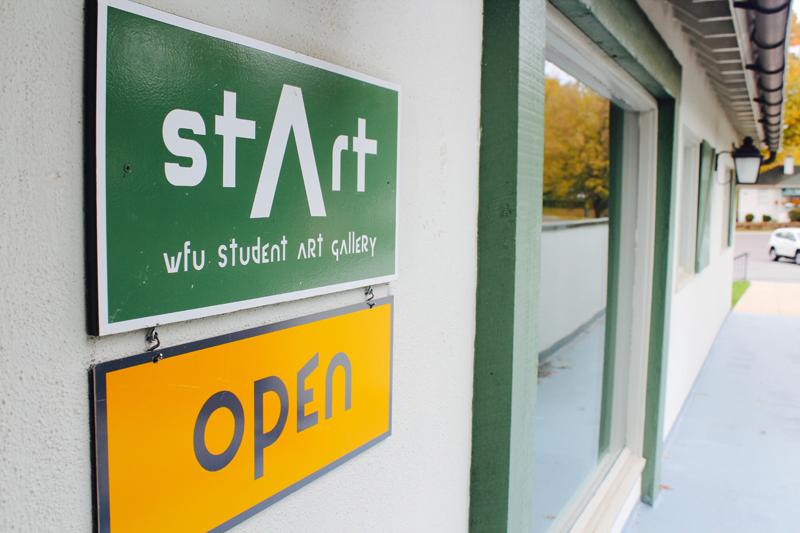Meet the new stArt Gallery Manager, Brittany Forniotis.
What is the stArt Gallery?
The stArt Gallery opened in 2009 to provide Wake Forest students with a real gallery experience. We function like a gallery in New York City would, where there are exhibitions that rotate every three weeks. Students get a taste of the art world, but in a safe environment. No one is going to rip them off, and there are no binding legal agreements, but they get the experience of showing their work.

What kind of experiences do students gain from working with the stArt gallery?
It gives them practice thinking about an artistic statement. They learn to ask questions like, what does their collection mean? What are they trying to accomplish as an artist? They start to think about installation because it’s one thing to make a piece, but a whole different ball game to hang it on the wall. Also, they learn about event planning. When you’re painting, you aren’t necessarily thinking about the opening reception. They learn everything from managing financial documents to keeping up with the evolving social media scene for an art gallery.
How were you hired as the gallery’s manager?
The manager position is part of the Wake Forest Fellowship program. I applied in February of my senior year, and I interviewed for the position shortly after. I work from 10-6 p.m., six days each week; it’s my full time job.
What are some of your responsibilities?
Other than curating the shows, I do a lot of event planning. I work with the art department on student engagement initiatives, and I work with different student groups on campus. I try to be here for the students as much as I can. Managing stArt can be stressful, but it’s a good kind of stress.
Of all your obligations, which part of the job do you prefer?
I enjoy the research and the curating side of things the most. I’m pretty introverted, so the receptions and the parties aren’t really for me. I like planning them, but I don’t like being the center of attention when they’re happening. I’m very proud, but I would rather sit back and watch everyone enjoy themselves.
How do you feel at the conclusion of a show?
It’s a feeling of intense relief. Our shows always open on a Tuesday, and that morning is the most relieving. Usually I work over the weekend to install the show, and it is a lot of physical labor. I also feel a little bit of pride for myself and for everyone involved. Like for the exhibition we’re doing now, seeing the artist’s face when she first walked in the gallery was a great moment.
What is the theme of the current exhibition?
“From Chamba” opened just last week. Last year Cami Burruss, a senior studio art major, applied for a grant to fund her trip to India so she could study a 17th century miniature painting under a guru. She created roughly 11 paintings that are on display in the gallery. Alongside the paintings, she explains the Hindu deities and why they are drawn the way they are.
How did you decide to curate such a unique show?
Cami first came with all of her paintings in a folder. We walked through the different methods of displaying her work and how they would look in the gallery. We thought about what would be the cleanest presentation and chose minimalist frames. It was great to have her come to the gallery after I had installed everything, and she got to see her art displayed in a commercial gallery. Everything was done perfectly, and it really fulfilled her dream of having her work shown.
Have you ever had your own artwork shown in the stArt Gallery?
Even though I wasn’t a studio art major, I did have a couple pieces shown. For my sculpture class, I hand sewed a dress out of paper. I was thinking a lot about fading memories and ghostliness. The paper was really thin and I hung the dress from the ceiling. It resembled the way you think about childhood memories.
Did you decide to hang the dress from the ceiling yourself?
The artist has complete control over how the piece is shown. Right now I am planning my next show, which is for a drawing class. I have a student whose drawing is of tumbling rocks, and it’s on huge butcher paper. We spent 20 minutes deciding how it could hang from the ceiling but sort of cascade down a wall. Students can have the final say. But if they don’t want to, then I do it for them.
Are you planning on continuing your career in the commercial art industry after the conclusion of your fellowship?
Not in the art world, but more in academia. Next year I hope to apply for graduate school to study medieval architecture. I’d like to be a professor or work at a research institute. If that doesn’t work out, I would love to open up my own bakery.
How has working with the art gallery prepared you for future careers?
It has made me learn to deal with other types of people. As a student, it is easy to block out that noise of different personality types. But when I’m working at the stArt Gallery, I don’t have that luxury. I compromise with everyone and make things work.










